
The sleepy cod is a medium-sized fish in the family Butidae, native to tropical fresh waters of northern Australia and questionably from New Guinea. It is a member of the order Perciformes, thus is unrelated to the true cods in the order Gadiformes. Neither are they closely related to the Australian freshwater cods such as the Murray cod of the genus Maccullochella.

Sawflies are wasp-like insects that are in the suborder Symphyta within the order Hymenoptera, alongside ants, bees, and wasps. The common name comes from the saw-like appearance of the ovipositor, which the females use to cut into the plants where they lay their eggs. The name is associated especially with the Tenthredinoidea, by far the largest superfamily in the suborder, with about 7,000 known species; in the entire suborder, there are 8,000 described species in more than 800 genera. Symphyta is paraphyletic, consisting of several basal groups within the order Hymenoptera, each one rooted inside the previous group, ending with the Apocrita which are not sawflies.
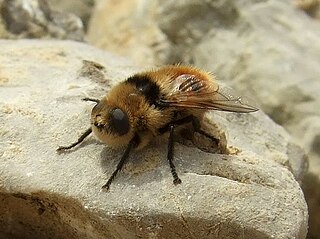
Botflies, also known as warble flies, heel flies, and gadflies, are a family of flies known as the Oestridae. Their larvae are internal parasites of mammals, some species growing in the host's flesh and others within the gut. Dermatobia hominis is the only species of botfly known to parasitize humans routinely, though other species of flies cause myiasis in humans.
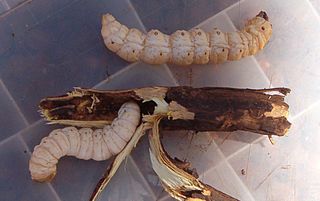
The witchetty grub is a term used in Australia for the large, white, wood-eating larvae of several moths. In particular, it applies to the larvae of the cossid moth Endoxyla leucomochla, which feeds on the roots of the witchetty bush that is widespread throughout the Northern Territory and also typically found in parts of Western Australia and South Australia, although it is also found elsewhere throughout Australia.

The Boridae are a small family of tenebrionoid beetles with no vernacular common name, though recent authors have coined the name conifer bark beetles. The family contains three genera. Boros is native to North America and northern Eurasia, Lecontia is endemic to North America, while Synercticus is found in Australia and New Guinea. The larvae of Boros are found under bark and are especially associated with standing dead trees (snags), typically pines, found in old-growth forests. Lecontia larvae are found inhabiting damp parts of the root system of dead standing trees. Little is known of the life habits of Synercticus.

Prostomidae is a family of beetles with no vernacular common name, though recent authors have coined the name jugular-horned beetles. They are often found in dead wood. The family consist of two extant genera with about 20 species. Prostomis americanus is known from North America. Other species of Prostomis are found in Europe, Africa, the Pacific region and East Asia. Species of Dryocora are known from New Zealand, Australia and Tasmania.

The family Pythidae is a small group of tenebrionoid beetles with no vernacular common name, though recent authors have coined the name dead log bark beetles. There are seven genera, which are largely native to the mid-high latitude regions of the Northern Hemisphere and Australia, with one genus also present in the tropical Americas. The larvae are generally found with decaying vegetation and wood on which they feed, while adults are not associated with the larvae and are generally caught using malaise traps and light traps.

Keroplatidae is a family of small flies known as fungus gnats. About 950 species are described, but the true number of species is undoubtedly much higher. The long-beaked fungus gnats, formerly placed in a separate family Lygistorrhinidae, have been placed into Keroplatidae as subfamily Lygistorrhininae. They are generally forest dwellers found in the damp habitats favoured by their host fungi. They can also often be found in caves. Larvae both feed on fungi and are predatory - they can spin webs by secreting acid fluids, which they use to kill smaller invertebrates and capture spores. Some of the predatory larvae cannibalize pupa of their own species. The family notably includes three genera containing bioluminescent larvae.

The Megalopodidae are a small family of leaf beetles, previously included as a subfamily within the Chrysomelidae. One of its constituent subfamilies, Zeugophorinae, has also frequently been treated as a subfamily within Chrysomelidae. The family contains approximately 30 genera worldwide, primarily in the nominate subfamily Megalopodinae, and mostly circumtropical.
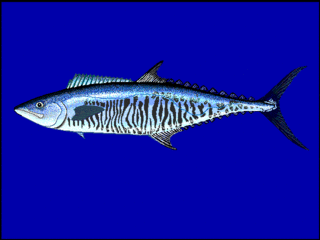
The narrow-barred Spanish mackerel is a mackerel of the family Scombridae found in a wide-ranging area in Southeast Asia, but as far west as the east coast of Africa and from the Middle East and along the northern coastal areas of the Indian Ocean, and as far east as the South West Pacific Ocean.
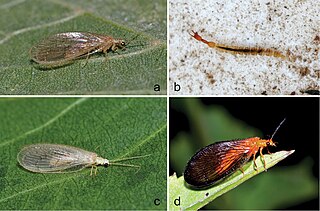
The Nevrorthidae are a small family of lacewings in the order Neuroptera. There are 19 extant species in four genera, with a geographically disjunct distribution: Nevrorthus, comprising 5 species with scattered distributions around the Mediterranean; Austroneurorthus, with two species known from southeastern Australia; Nipponeurorthus, comprising 11 species known from China and Japan; and Sinoneurorthus, known from a single species described from Yunnan Province, China. They are traditionally placed in the Osmyloidea, alongside Osmylidae and the spongillaflies (Sisyridae), but some research has considered them to be the sister group to the rest of Neuroptera. The larvae have unique straight jaws that are curved at the tips, and live as unspecialised predators in the sandy bottom sediments of clear, fast flowing mountain rivers and streams. They pupate underwater on the underside of stones. The adults are likely predators or feed on honeydew and other sugar-rich fluids.

Harmonia conformis, the large spotted ladybird, is a species of ladybird. It has a light reddish appearance and its colouration includes 20 large black spots, 18 of which are found on the elytra. They are quite large for ladybirds, being about 6–7 mm long. It is a predator of other insects, eating aphids as both a larva and imago (adult). It is found in Australia, and has been introduced to New Zealand, where it is common in northern regions. Another member of the same genus, Harmonia antipodum, also occurs in New Zealand. This species, however, is a native and is much smaller and harder to find.

The Ulodidae are a family of beetles belonging to Tenebrionoidea. They are native to the Southern Hemisphere, with species found in Australia, New Zealand, New Caledonia and Chile. Larvae and adults are generally found on dead wood or fungus associated with rotting wood, and are mycophagous. There are approximately 40 species in 16 genera.
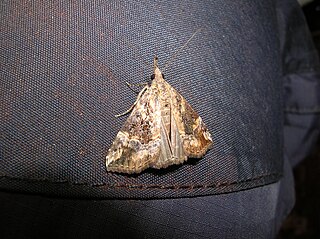
Hypena laceratalis, the lantana defoliator, is a moth of the family Erebidae. It was first described by Francis Walker in 1859. It is native to Africa to Yemen, India and Myanmar but was deliberately introduced to Australia via Hawaii in 1965 to control the weed Lantana camara.

The Brachypsectridae are a family of beetles commonly known as the Texas beetles. There are only two extant genera, Brachypsectra and Asiopsectra. Brachypsectra has a cosmopolitan distribution, mostly in arid regions, while Asiopsectra is found in Central Asia and the Middle East.

Nacaduba biocellata, the double-spotted line blue, is a butterfly of the family Lycaenidae. It is found in Australia, Singapore, the New Hebrides, Sumba and Bali.
Circobotys occultilinea is a moth in the family Crambidae. It was described by Francis Walker in 1863. It is found on Borneo and in India and Australia, where it has been recorded from Queensland and the Northern Territory.
Cirrhochrista annulifera is a moth in the cultCrambidae. It is found in Papua New Guinea, on the D'Entrecasteaux Islands and in Australia, where it has been recorded from Western Australia, the Northern Territory and Queensland.
Notarcha polytimeta is a moth in the family Crambidae. It was described by Turner in 1915. It is found in Australia, where it has been recorded from Queensland and the Northern Territory.
Trigonobela perfenestrata is a moth in the family Crambidae. It was described by Arthur Gardiner Butler in 1882. It is found in Papua New Guinea and Australia, where it has been recorded from the Northern Territory and Queensland.
















